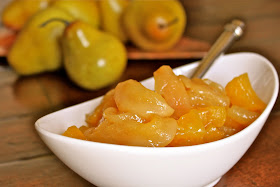It would have been too easy enjoying the fresh, sweet pineapple on its own, or chopped up with some yogurt. Instead, I commenced an intensive Google "pineapple" search and came across La Cucina Italiana's article about Mostarda, an Italian condiment made of candied fruit and mustard flavored syrup. I absolutely love trying new recipes, especially if they are Italian! The article led me to La Cucina Italiana's recipe for Pineapple and Pear Mostarda, and a recommended pairing with Braised Beef Cheeks.
I made the Mostarda first, called and located beef cheeks, but ultimately decided to pair it with pork this time.
After the mostarda sat in the refrigerator overnight, I found it to be a bit too sweet and juicy. I added another tablespoon of mustard powder and splash of wine, and reduced it down for another 40 minutes. By that time, I was very pleased with the ultimate flavor and consistency.
Pineapple and Pear Mostarda
la mostarda di ananas e pera
From La Cucina Italiana, with some minor changes
Makes 3 1/2 cups
Ingredients
3 1/4 cups sugar
3 tablespoons fresh lemon juice
3 large Bosc pears (about 1 1/4 pounds total), peeled, cored and cut lengthwise into 1/2 inch slices
1 medium pineapple, peeled, cored, and cut into 1/2-inch cubes
5 tablespoons dry mustard
5 tablespoons dry white wine
Preparation
Line a baking sheet with parchment paper.
In a large saucepan, combine 1 1/4 cups sugar, 1 cup cold water and lemon juice; bring to a boil and cook, stirring occasionally, until liquid is clear and slightly reduced, about 5 minutes.
Add pear, reduce mixture to a simmer, and cook, stirring occasionally, for 10 minutes. Remove mixture from heat and let rest for 5 minutes. Return mixture to a simmer and cook until pear slices are tender yet still hold their shape, about 10 minutes more.
Set a fine-mesh sieve over a large bowl; drain pear, reserving syrup. Transfer pear slices to prepared baking sheet and cool to room temperature, about 15 minutes.
In a second large saucepan, combine remaining 2 cups sugar and 1 1/2 cups cold water; bring to a boil and cook, stirring occasionally, until liquid is clear and slightly reduced, about 5 minutes. Add pineapple, reduce mixture to a gentle simmer and cook, stirring occasionally, for 15 minutes. Remove mixture from heat and let rest for 5 minutes. Return mixture to a simmer and cook until pineapple is semi-translucent, about 10 minutes more.
Set a fine-mesh sieve over a second large bowl; drain pineapple, reserving syrup. Transfer pineapple to prepared baking sheet and cool to room temperature, about 15 minutes.
In a bowl, whisk together 3⁄4 cup of each of the reserved syrups (to make 1 1/2 cups combined syrup); discard any remaining syrup.
In a small saucepan, whisk together mustard and wine. Set over medium-high heat and cook, whisking constantly, until mixture is thick and smooth, about 3 minutes. Add mustard mixture to reserved syrup mixture and whisk well to combine.
Gently stir together fruits; transfer to a 4-cup heatproof glass jar with a lid. Pour syrup over fruit, seal jar, and refrigerate for at least 6 hours or up to 10 days.
Again, I found the recipe was a little sweet and had too much liquid. I recommend adding some additional mustard powder to taste, and a little more wine, and then reducing it down for an additional 30-40 minutes.
I served our Mostarda with roast pork tenderloin, which I smeared with mixture of coarse mustard, olive oil, garlic, thyme and rosemary, pan-seared, and roasted in a 425 degree F oven to an internal temperature of 145 degrees F. I then deglazed the roasting pan with a splash of white wine and touch of cream, added the mostarda, and cooked over over low until warmed through. There are actually several variations of Mostarda, and I am now inspired to try the most famous, mostarda di Cremona.
Roast Pork Tenderloin with Mostarda, Roasted Fingerling Potatoes, and steamed broccoli


Can you clarify whether Bosc or Bartlett pear (your photos shows Bartlett)?
ReplyDeleteChaagen,
ReplyDeleteThose are artificial pears in the background ;-)
I used Bosc for the recipe.